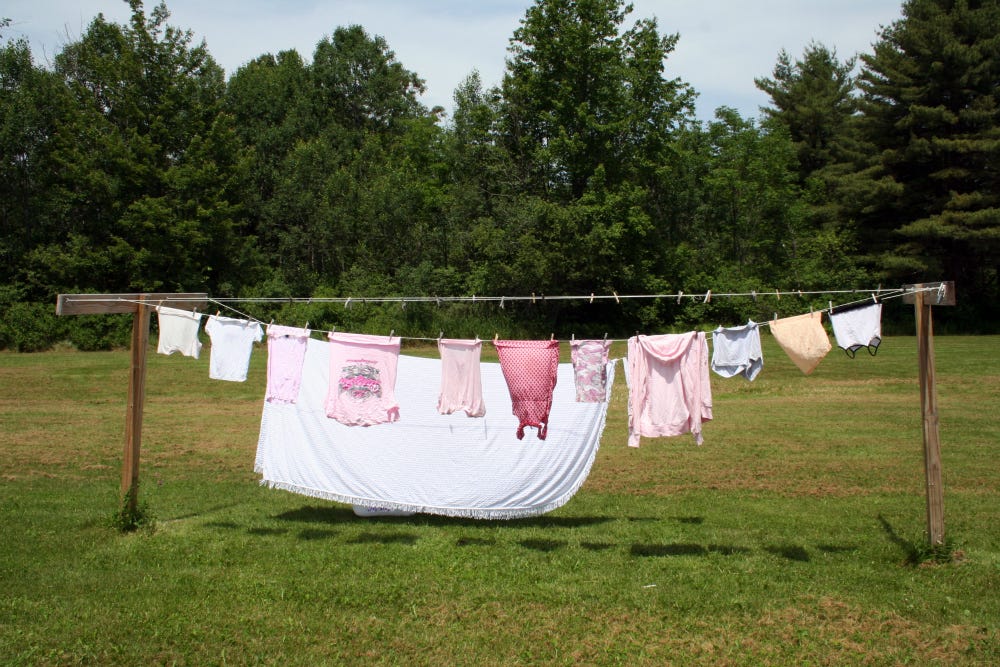Drying clothes online: saving money and saving the planet
More "News You Can Use"
I grab four or five clothespins in my left hand as I bend down to pick a shirt out of the laundry bucket. After a few years of doing this, I’ve gotten used to this routine. Holding a few extra pins keeps me from having to reach into the clothespin bag every time I hang a shirt or pair of pants, speeding the process along. This is part of my routine two or three times a week now, hanging our laundry out to dry on a clothesline.
Growing concerned about global warming and my contribution with my car, refrigerator, computer, and any other modern device that plugs in, moves, or shakes, I put up a clothesline about ten years ago outside the house that my wife and I live in. Let’s accept the carbon emissions of using a clothes washer. Washing clothes by hand is a chore that i would not wish to undertake. Taking those clothes out of the washing machine and tossing them into the the dryer can increase the amount of carbon dioxide from that load of laundry by more than five times than if those clothes are dried on a clothesline.
On average, a clothes dryer throws about 1.2 tons of carbon into the air every year, and there are about 90 million dryers in the U.S. Drying our clothes with these contraptions therefore sends about 108 tons of CO2 into the atmosphere each year. It’s a fraction of the millions of tons of CO2 that our cars and trucks produce in the same year and another fraction of the CO2 produced from industrial production. It is nonetheless a lot of carbon thrown in the air that would not be there otherwise. Also, those statistics are just the United States. There are plenty of clothes dryers in Argentina, Germany, and anywhere else that you have people, a power source, and laundry.
When I first started hanging our clothes out, I thought that this would be a sacrifice, that I would dislike the extra labor involved or the change of routine. I was wrong. It’s a chore that forces you to take your time, like almost all the chores that sustained our ancestors for millennia—milking goats or cows, planting crops—the chores that became part of our DNA as human beings, the work that brings quietude and a feeling of well-being.
Some of my earliest and most pleasant memories are of being in the backyard with my mother as she hung laundry out to dry. I remember when she washed our bed sheets and put them on the line. I would run between the brilliant white billowing walls. It seemed magical to me how, in summer, the air seemed so cool as I raced the length between the clothesline poles.
I hang up a pair of my pants. I’ve learned that it’s best to hang pants legs down. They dry quicker this way. I haven’t read up on this, but I suppose it has something to do with the way water flows from around the waist and pockets and the way water flows through the clothing as it dries. If I hang pants ankles up, it can take a real long time for the waist and pockets to dry. Long sleeved shirts dry best upside down, with the sleeves dangling.
The wind picks up a little from the east. This is good. Easterly winds come in from the desert. The humidity will be low, and these shirts and pants will dry quickly. I’ve always been as aware of the weather as the next person, bundling up when it’s cold and carrying an umbrella for rainy days. But since I’ve started hanging our clothes out, I’m a bit more aware of what is going on in my environment. Is it humid today? Windy? The weather can make all the difference between getting one or two loads done in a day.
Line-dried clothes enforce a routine on doing laundry. Before I put up the clothesline, I’d throw laundry in the washer any time of day, morning, afternoon, evening. Now, on a laundry day, I know exactly what I’m going to do after breakfast. The clothes go in the washer, and within the hour I have the line and clothespins all set to go. I get the laundry up by a little after nine or ten.

There are some disadvantages, chief among them the added ironing that I wind up doing from time to time. I have dress shirts that are “iron free.” When they get tossed in the dryer, they come out looking crisp and rarely need a touch up with an iron. It’s a different story when they’re put on a line. They can wind up as wrinkled as a prune.
On the other hand, I save some money. I’m not spending a dime on electricity or gas to power my dryer. I don’t have any direct proof of this, but my clothes are supposed to last longer when they’re dried outside. It makes sense. Every time they’re dried on a line they are not being par boiled while they tumble against each other. Best of all our clothes smell fresh and clean now. The freshness stays with the shirts, sock, and bed sheets, so that our closets smell fresher.
I’ve remarked that I’ve installed a wind powered clothes dryer at my house, and it’s interesting to note that older folks, the ones like me who remember their mothers and grandmothers in the backyard with their laundry baskets, are the ones to get the joke. Some of the younger folks get a vag
ue look in their eyes when they hear me say “wind powered clothes dryer.” Perhaps they imagine that I went online and bought a device with a windmill and a generator that I hammered to the roof of my house and connected all of its wires to a sleek looking machine in my laundry room.
There probably is a company that makes such a dingus. And it is probably marketed as a green product. I would guess that such a device would be a good move, and it would lead to less CO2 in the air. There is nonetheless the question of all the metals used in making the generator and motor, not to mention all the wires needed to move all the electricity around.
Winston Churchill once said “We shape our buildings; thereafter they shape us.” Along with buildings, Churchill could well have included ballpoint pens, space shuttles, clothes dryers, and everything else that we manufacture. Not only our buildings, but all the things that we shape and form into being also shape and form us as well. In a hunter-gatherer society everyone thinks like a hunter-gatherer. In an industrial society we all think industrially. And so for us, if there is a problem, there has to be something that engineers can figure out an answer to, a new product that does things better, faster, and more efficiently, that will be the answer. Global warming? Introducing the new wind powered Dryomatic, with computer controlled thingamabobs!
We environmentalists see ourselves in opposition to industrialists and developers. They would pave over the wetlands we see as essential and wreck even more havoc on the mountaintops of West Virginia. We need to recognize, however, that on a very fundamental level we think as they do. We can’t help it. It’s in our DNA. Inside every tree hugging environmental activist beats the heart of a techno-frenzied consumerist eager for the next eco-friendly device. Look at any environmental magazine. There will be ads and product reviews for dozens of newfangled compost enhancers, hybrid cars, solar panels, and anything else that gives us a warm, environmental fuzzy.
Please don’t get me wrong. Our lights should be low-watt and our cars should not be gas-guzzlers. But we should realize that we are still part of the social machinery of our industrial society, and we are still nonetheless switching on lights and driving cars. Driving a hybrid or even an electric vehicle is greener than driving any SUV, yet you’re still driving something—using resources and putting CO2 in the air—when you zip down the interstate in your Prius or even your Tesla. “Green technology” may not be a full bore oxymoron, but it does have a twinge of doublethink to it.We need technological advances to better our situation. But there are other solutions as well—when the lights, though they are low watt, are not turned on, when the car, despite its being a hybrid, is not driven, when the high efficiency clothes dryer is not turned on and the clothes go up on the line instead—that require us to consider things differently, nontechnically, nonindustrially. What I’m suggesting is we need to think outside the Prius.
My clothesline, I’ve reduced my carbon footprint by putting it up and using it. It has also opened up a new area of life for me. Besides the benefits of saving money and fresher smelling clothes, it has given me an unhurried quiet time of day when I am more attuned to my surroundings, a nontechnical and nonindustrial experience that would be unavailable to me had I put up an all new, green, wind powered Dryomatic clothes dryer.
For more environmental news and science follow me on Twitter @EcoScripsit.



hi
This works in freezing weather as well. I hung up sheets to dry outside in freezing windy weather in Detroit Michigan and watched them freeze in a billowy shape of the wind. When I brought them in the defrosted perfectly dry quickly.
For rainy or damp cold weather you are out of luck.
I’m a long time dryer of clothes outside. I’ve found in hot weather the clothes dry faster than they would in a machine. I often hang them out on my outdoor furniture in neighborhoods where clothes lines are not allowed or are unavailable or I use a low folding rack. This makes my clothes invisible to hostile neighbors. Hanging shirts buttoned up on hangers in trees or on porch hooks also works.
I still use a dryer (heat pump) for damp rainy days.